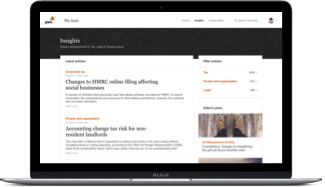You may have heard that LIBOR is set to be replaced. In this article, Sonia Thind considers the key tax consequences of that for corporates.
The replacement of LIBOR first caught the headlines in the LIBOR fixing scandal of 2012 and a desire to reduce the opportunity for misconduct. A number of replacement interest rates are being developed, including SONIA (GBP), SOFR (USD) and ESTER (EUR) which all use historic transactions.
In light of its importance and widespread use, replacement of LIBOR will require great care to facilitate transition and minimise disruption. It is not clear at the moment how the transition will be achieved in third party arrangements. It is likely that it will be necessary to review contracts on a contract-by-contract basis in order to determine the impact and then agree and implement a replacement rate.
In the case of intra-group agreements, it may be possible to stipulate an alternative rate in one sweeping motion. This does though, lead to the question as to which of the new reference / benchmark rates to use. It may not be as simple as replacing LIBOR with say SONIA. This is because SONIA is intended to be based on overnight sterling rates and so would not be an appropriate replacement for 3 month USD LIBOR. The replacement may also be an unfunded or risk-free rate, giving rise to further differences.
From an accounting perspective, it may be possible to account for the change on a go forward basis; adjusting the future finance costs for the variation in the future cashflows. If this is the case there will be no accounting entries on transition and therefore also no tax consequences on transition.
From a tax perspective, it will also be necessary to consider whether the resulting interest rate remains arm’s length. Where the loan agreement specifically states that the rate is LIBOR and has no wording in the event it ceases, it may not be as simple as replacing LIBOR with say SONIA, as the two rates differ by approximately 0.2%. It may therefore be necessary to model out how a potential change to the benchmark rate (eg to SONIA) affects the intra-group loan profile and tax consequences. In the event the agreement states that LIBOR will transition to SONIA, and the borrower signed up to the agreement, then it is arguable that the borrower was aware of the situation from start. There is still a question as to whether a borrower would sign up to that initially, however this is less defined.
Another common transaction, which is impacted, is where a group has entered into a hedge in order to ‘fix’ the interest flows on a floating rate LIBOR based loan. Here in order for the hedge to continue to be effective it will be necessary to ensure that both the loan and the hedge reflect the replacement of LIBOR in the same way. Where hedge accounting has historically been applied the hedge designation documentation will also need to be updated and other complications may arise.
Where new loans are being entered into which include a reference to LIBOR, a clause detailing what happens when LIBOR is replaced should be included. This might reference a fall back rate like SONIA or an undertaking to transition to an equitable rate.
The key tax takeaways for corporates are as follows:
- Review contracts governing intra-group financing arrangements to ascertain which depend on LIBOR as the reference / benchmark rate.
- Monitor developments in the regulatory space as to the expected replacement of LIBOR and transition to the new benchmark rate.
- Model out how a potential change to the benchmark rate (eg to SONIA) may impact the intra-group loan profile and tax consequences.
- Consider including clauses (especially in new, longer term, external and intra-group contracts) to deal with the fact that LIBOR may be replaced.
For further information, please contact Sonia Thind or your usual PwC advisor.
